 |
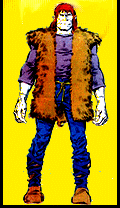 |
|
FANTASTIC
FOUR, SPIDER-MAN, FRANKENSTEIN
MONSTER &
THOR
BACK TO BACK IN AN
AUGUST
1975 MARVEL MULTI-MAGS
|
|
|
|
| |
|
| |
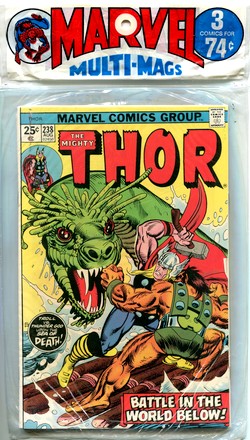 |
|
FANTASTIC
FOUR #161
MARVEL
TEAM-UP #36
MIGHTY
THOR #238

In spite of the hugely successful
comeback of the superhero genre in the early
1960s, the comic book industry had a fundamental
problem: its traditional sales points were fading
away. Small stores that had carried comic books
for decades were pushed out of business by larger
stores and supermarkets, and newsagents started
to view the low
cover prices and therefore tiny profit margins comics had to offer as a nuisance.
|
|
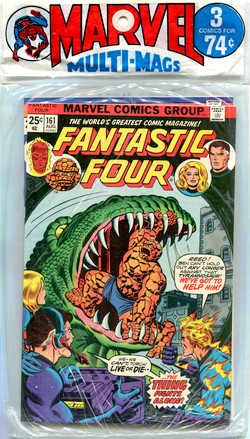 |
|
| |
| Comic book
publishers needed to open up new sales opportunities and
tap into a new customer base. One place these potential
buyers could be found was the growing number of
supermarkets and chain stores. But in order to be able to
sell comic books at these venues, the product would have
to be adjusted - such as packaging several comic books
together in a transparent plastic bag. |
| |
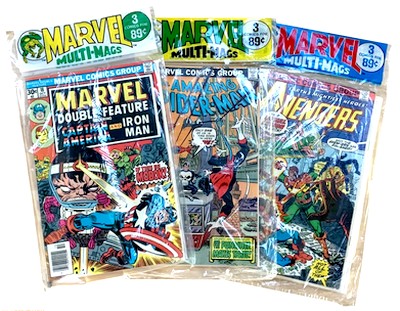
|
|
Pioneered
by DC Comics (who came up with the Comicpac concept in 1961), this
resulted in a higher price per unit on
sale, which made the whole business of
stocking them much more worthwhile for
the seller. At the same time the product
blended in with most other goods sold at
supermarkets, which were also
conveniently packaged. DC's Comicpacs
were a success - so much so that other
publishers quickly started to copy the
concept. Marvel produced a series of Marvel
Multi-Mags in 1968/69, but only
fully embraced selling multiple
comic books packaged in a sealed plastic
bag at supermarkets, large grocery stores
or gas stations as of the early 1970s.
It didn't really
matter that buying these three comic
books in a comicpack for say 89¢ (rather
than from a newsagent for 90¢ in that case) clearly presented no
real bargain - it was the opportunity and
convenience to pick up a few comics at
the same time parents and adults did
their general shopping. Neatly packaged,
it almost became an entirely different
class of commodity.
|
|
|
| |
|
| |
| The comic books contained
in this specific MARVEL MULTI-MAGS
are all from the August 1975 cover date run,
which meant that they were actually on sale at
newsagents in May 1975 - although there could be
quite a delay in terms of actual availability of MARVEL MULTI-MAGS at some sales
points, resulting in some Multi-Mags on display
containing "semi-recent books (typically
about nine months old)" (Brevoort,
2007). Considering the packaging and distribution
process, this doesn't really seem too surprising. |
|
| |
| No titles had
permanent slots in the MARVEL MULTI-MAGS, but issues of Fantastic
Four and Thor would show up in a
reliably regular way, and Marvel Team-Up could
be found quite often too. But even with these
fairly regular titles there was never any
guarantee of an uninterrupted flow of consecutive
issues - and therefore a distinct possibility of
missing out on a part of the storyline, since the
continuity of the Marvel Universe of the 1970s
was such that plots and storylines usually
evolved over more than one issue. This didn't exactly make the MULTI-MAGS an ideal way of getting
your Marvel comic book fix. On the other hand, this was a
common fate of the average comic book reader in
the 1970s, whether their comic books came
packaged in a plastic bag or as single issues
from a display or spinner rack. Back in those
days, an uninterrupted supply of specific titles
was, quite simply, not guaranteed. Not worrying
too much about possible gaps in storylines wasn't
really a big thing - besides, you would usually
get a recap of "what happened so far"
on the first page.
So
all in all it simply was a part of being a comic
book fan in the 1970s - as were the monthly
Bullpen Bulletins (which were the responsibility
of the editor-in-chief) and the in-house
advertising.
|
|
| |
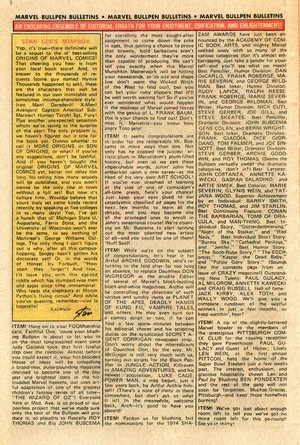 |
|
| In August 1975, the
Bullpen Bulletin was still on its way
through the alphabet as far as its title
was concerned, arriving at the letter E -
which resulted in the typically
alliterative and somewhat nonsensical
title "An Endearing Ensemble of
Editorial Errata for your Enjoyment,
Edification, and Enlightenment!". The headline item of
Stan Lee's Soapbox column was
the planned sequel to the massively
successful Origins of Marvel Comics.
Besides musings as to the title of said
book, Stan "the Man" also
managed to mention that he had been
invited to talk at five colleges on five
consecutive days. All of this exposure to
academia did not, however, prevent Lee
from misspelling Monty Python as
"Monte", along with an obvious
typo ("in case you've
wondering") in the last sentence of
his ramblings...
|
|
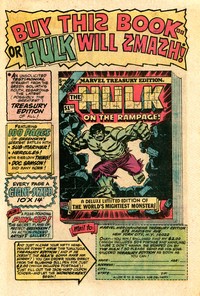
In-house ad from Conan #53
|
As for the
actual Bullpen Bulletins' various
ITEM!
bullet points, they were - as usual - mostly
concerned with new and changing assignments of
various writers, artists, and editors (such as
Archie Goodwin now overseeing Marvel's range of
black and white magazines).
|
|
| |
| A big push was also given
to the up and coming adaptation of The Wizard
of Oz - an unlikely subject matter for the
House of Ideas, but one that readers would be
hearing a lot about over the next few months.
There weren't too many in-house ads that month,
but the full-page plug for the Hulk Treasury
Edition #5 certainly was an attention
grabber. |
|
| |
|
| |
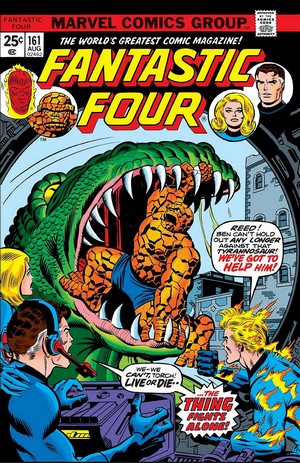
|
|
FANTASTIC
FOUR #161
August 1975
(monthly)
On Sale: 27 May 1975
Editor
- Roy Thomas
Cover - Rich Buckler (pencils) & Joe
Sinnott (inks)
"All The World Wars At
Once!" (18
pages)
Story - Roy
Thomas
Pencils - Rich Buckler
(layouts/breakdowns), Joe Sinnott
(finished art)
Inks - Joe Sinnott
Lettering - Joe Rosen
Colouring - Glynis Wein
STORY
OVERVIEW - This story
continues from Fantastic Four #160 and is
part 2 of 4. Events take place in three
parallel worlds: The world of the
Fantastic Four (the planet Earth we
know), an Alternate Earth
("Earth-A"), and an "Earth
of the 5th Dimension". The special
twist is that certain parallels to the
Fantastic Four of our world exist on
Earth-A (where Reed Richards is actually
the Thing) whilst the Human Torch (of our
Earth) is helping out in the 5th
Dimension. Chaos and confusion
reign as three worlds move towards
all-out war...
|
|
|
| |
| The concept of "parallel
earths" was introduced to comic books by Gardner
F. Fox in his famous "Flash of Two Worlds"
story (Flash #123)
in September 1961, and DC has made extensive (and
sometimes even excessive) use of its
"multiverse" ever since. |
| |
| Marvel,
on the other hand, rarely explored parallel
realities with characters that are the same yet
different, so this foray of the Fantastic Four is
something of an exception - and it is probably no
coincidence that Roy Thomas was at the helm of
this storyline, given his well-known soft spot
for DC's history. And Thomas handles it well, providing a
clear plot which leaves little room for confusion
(although to be on the safe side, he and Rich
Buckler would "sketch it out" for
readers in two charts in the next story
segment, in Fantastic Four
#162).
In
addition, Buckler provides clear visual clues for
readers to distinguish e.g. which Thing is which,
as the "Earth-A" Thing wears brown
pants (in contrast to Ben Grimm's famous blue
ones) and also sports a torn shirt (which would
even make the visual differentiation possible
with later black and white reprints).
|
|
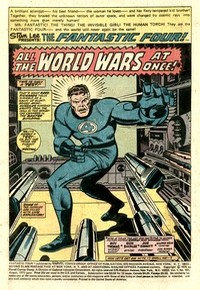 |
|
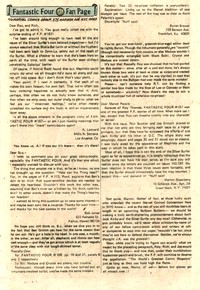 |
|
| |
| Roy Thomas had first scripted a
story for Marvel's First Family in Fantastic Four #119
(February 1972) before becoming the title's regular
writer from September 1972 to April 1973 (Fantastic
Four #126-133) and April 1975 to April 1977 (Fantastic
Four #157-181). |
| |
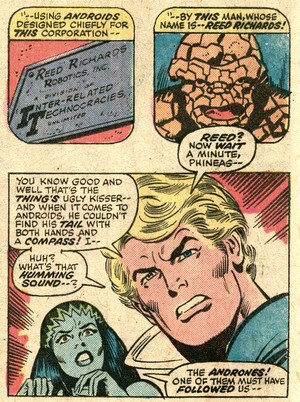
|
|
His tenure was
appreciated and lauded by fans
(as the letters page from this
issue also clearly shows). Thomas
was always at his best when he
felt connected to what he was
writing, and the Fantastic Four
were no exception.
"Much
as I loved the character
Spider-Man, what I wanted to
do was Fantastic Four."
(Roy Thomas in Cooke, 1998)
Arguably Roy
Thomas returned the Fantastic
Four to their roots whilst at the
same time refining their family
dynamics and individual
characterization.
|
|
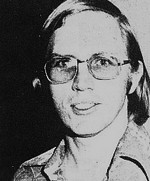
Roy Thomas
|
As a result, the stories
gained a complexity that FF lore had
somewhat lacked for some time. And in
this issue specifically, Thomas also put
on display some of his special wit;
clearly aware of how untypically close he
was taking this story to DC tropes, he
inserts not one but two little
tongue-in-cheek digs which can also be
seen as signalling "don't take me
too seriously on this one". The
first is an exposition box that reads "While,
back on Earth-I (Oooops! Wrong
Comic-Mag...)", and the second
is a line of dialogue where the ever-lovin'
Thing states "... while we head
for New York. That is what ya call it
here, ain't it -- nuthin' phony like
Bigville or Cosmopolis?".
Clearly, Roy Thomas was
enjoying himself.
|
|
|
| |
| And so could the readers. At face
value, Fantastic Four #161 would seem to be a
less than ideal issue to find in a MARVEL
MULTI-MAGS, given that it contains part 2 of a
four-part story arc, but that was the magic of Marvel
Comics in the 1960s and 1970s - you could still get lucky
and enjoy a fast paced and entertaining single issue
without ever seeing any of what went on before or after.
And Fantastic Four #161 is exactly that kind of
comic book. |
| |
 |
|
Currently
available data regarding Marvel's
MULTI-MAGS
from 1975 is extremely
limited to say the least, making
it impossible to say for certain
whether readers would be able to
follow this four part adventure
in full through MULTI-MAGS purchases.
But with a little bit of
luck, readers had certainly been
able to pick up the subsequent
issue, Fantastic
Four #162. |
|
|
|
| |
|
| |
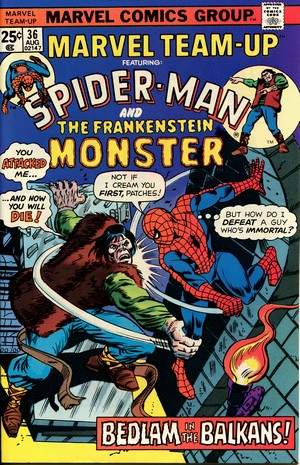
|
|
MARVEL
TEAM-UP #36
August
1975
(monthly)
On Sale: 27 May
1975
Editor - Len Wein
Cover - Ron Wilson (pencils)
& Mike Esposito (inks)
"Once
Upon A Time, In A Castle..."
(17 pages)
Story
- Gerry Conway
Pencils - Sal Buscema
Inks - Vince Colletta
Lettering -
Charlotte
J[etter]
Colouring - Al Wenzel
STORY
OVERVIEW - As
Spider-Man foils a bank robbery
he is mysteriously taken out by a
beam from out of nowhere - and
when he regains consciousness, he
finds himself strapped to what
looks like an operating table in
a dungeon. Stranger still, right
next to him, the friendly
webslinger sees the Frankenstein
Monster, caught up in the very
same predicament. Both, it turns
out, are prisoners of Baron
Ludwig von Shtupf. A
self-professed "Monster
Maker" (albeit without any
direct link to the
Frankensteins), he plans to fuse
their characteristics in order to
create an army of superhuman
monsters...
|
|
|
|
| |
| Spider-Man had been Marvel's signature super-hero and
flagship character since the late 1960s, but in spite of
his popularity and ability to generate consistently high
and rising sales both of his own title Amazing
Spider-Man and on the merchandise front, he still
only appeared as starring character in one title until
December 1971 - when Marvel Team-Up #1 went on sale with a March 1972 cover
date. The title was an
instant success, and generally featured Spider-Man
with a rotating cast of "guest stars" (of the
150 issues published between March 1972 and February
1985, only 11 did not feature Spidey). Initially, this
formula produced a rather formulaic series, featuring a
string of unconnected and done-in-one-issue stories.
"Either Spider-Man or
that issue's guest-star would encounter a menace and
then by sheer chance cross paths with another hero
who would lend a hand. The title's guest-stars were
an equal mix of A-list characters whose presence was
likely to increase sales and fledgling heroes being
given exposure in the hopes of launching them into
stardom but who for the most part continued to
languish in obscurity." (Miller, 2010)
|
 |
| |
| Frankenstein's Monster
definitely was an unsual choice, but not
the first of Marvel's horror genre
characters to feature in Marvel
Team-Up, as Spider-Man had
previously already teamed-up with
Werewolf by Night (MTU #12, August 1973),
Ghost Rider (MTU #15, November 1973),
Brother Voodoo (MTU #24, August 1974),
and even Son of Satan (MTU #32, April
1975). The truly unusual aspect of
Spider-Man pairing up with Frankenstein's
Monster was the timing, as the latter was
about to have its (bi-monthly) title
cancelled after the September 1975 cover
date production run - and the conclusion
of this two-part story in Marvel Team-Up #37 would indeed coincide
with the last issue of Frankenstein Monster. It seems reasonable to
assume that having the Monster appear
alongside Marvel's most popular character
was an editorial decision and attempt to
boost the fledgling character, but by the
time Marvel Team-Up #36
and #37 hit the news stands it was
already beyond saving.
|
|
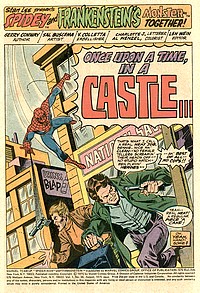 |
|
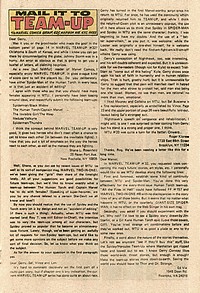 |
|
|
| |
| Writer Gerry Conway, penciller
Sal Buscema and inker Vince Colletta had no previous
experience with Marvel's Frankenstein Monster prior to Marvel
Team-Up #36, and the story
spread out over this and the next issue is completely
removed from the characters and events in Frankenstein
Monster. |
| |
 |
|
However, a
brief recap of the origin of the Monster is
featured that refers to specific events (such as
the fight with Dracula) and characters (e.g.
Ralph Caccone). This would have worked as a nice
shot in the arm for Frankenstein Monster,
but the lack of any explicit editorial
cross-reference to specific issues or even the
title as such would seem to be a strong
indication that the cancellation of the Monster's
own title became known to the editorial team
whilst it was preparing the issue. Bringing together Viktor
Frankenstein's creation and your friendly
neighbourhood webslinger in a meaningful way was
an almost impossible task - and the mere idea of
such an encounter had caused Frankenstein
Monster's original artist Mike Ploog to quit
the title in mid-1973.
"They
wanted to bring Frankenstein up to the 20th
century, and have him battle in the streets
of New York with Spider-Man, and I just
couldn't do that. (...) That's when I left
Frankenstein." (Cooke, 2001)
|
|
| |
| Gerry Conway tried to pull it off
by having the encounter take place in Eastern Europe
rather than the East Side, but the result (his final two
scripts for Marvel Team-Up) still comes across
as an essentially whacky story that requires utter and
complete suspension of both disbelief and common sense. |
| |
| However, once those switches are
all set to the "off" position, Conway's
yarn actually makes for some rather entertaining
reading, further helped along by mostly solid
pencils provided by Sal Buscema (his brother John
had drawn the Monster for Frankenstein
Monster #7-9 and the black and white Monsters
Unleashed #2, #4-5). The
task of inking Buscema's pencils fell to Vince
"Vinnie" Colletta, one of the most
prolific and at the same time most controversial
inkers the comic book industry has ever seen. He
could be extremely fast with his work and was any
editor's go-to-inker when a title was running
late (Bryant Jr., 2010). The downside to this was
the fact that Colletta would often cut corners by
erasing details or even major elements in the
pencil artwork, thus simplifying the pencil
artwork and ultimately his work. It helped to
meet deadlines and avoid having to pay hefty
printer's fines, but not all artists (and even
editors) were too happy with his approach
(Contino, 2005).
Coletta's inking on Marvel
Team-Up #36 generally looks a good average,
whereas he would do a terrible job on Bucema's
artwork in the conclusion of the story in Marvel Team-Up #37.
|
|
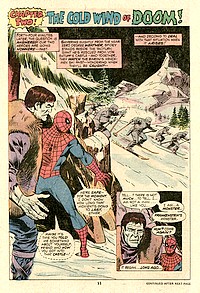 |
|
| |
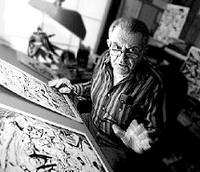
Sal
Buscema
(*1936)
|
|
But Buscema (who is somewhat
famously alleged to have once remarked that "pencilling is work, inking is a
pleasure") was far too much of a
professional (and a gentleman) to publicly voice
explicit criticism. In reply to an interviewer
stating that he didn't like Vince Colletta's inks
on Sal Buscema's work, he replied
"Well... yeah.
[laughter] I did complain, not about
Vinny Colletta, but just in general if I
was unhappy with an inker, I would voice
my opinion from time to time. Not
vociferously, because I'm affecting a
guy's livelihood and I don't want to do
that (...) For me, the priority is that
the man is earning a living. I'm sure
he's doing the best that he can do,
that's fine. Let's leave it alone."
(Sal Buscema in Amash, 2010)
|
|
| |
| Marvel Team-Up suffered
a few systemic problems, as the letters pages would often
clearly show. Whilst readers liked
the team-up formula, they seemed to increasingly feel
that the stories weren't too original (given the
recurring misunderstandings between the good guys
and resulting in-fights) and were asking for more
continuous plots rather than the "done in one
issue" stories (a wish granted in the case of Marvel
Team-Up #36 and #37). And there was always the
question of if and how the events portrayed in Marvel
Team-Up fitted into the general Spider-Man
continuity. These points would remain a challenge for the
writers, but they also made Marvel Team-Up
issues ideal for the MULTI-MAGS. |
| |
 |
|
As mentioned, readers
would - with a bit of luck - be
able to pick up the conclusion to
this story in a MULTI-MAGS the following
month. Horror characters
hardly ever showed up in a MULTI-MAGS, and Marvel
Team-Up #36 and #37 were
indeed the only occasion to catch
up with the Frankenstein Monster. |
|
|
|
| |
|
| |
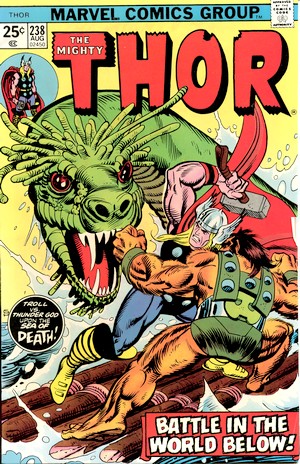
|
|
MIGHTY THOR #238
August
1975
(monthly)
On Sale: 13 May 1975
Editor - Len wein
Cover - Gil Kane (pencils) &
Al Milgrom (inks)
"Night
Of The Troll!" (18
pages)
Story - Gerry
Conway
Pencils - John Buscema (layouts),
Joe Sinnott (finished art)
Inks - Joe Sinnott
Lettering - John Costanza
Colouring - Don Warfield
STORY
OVERVIEW - Thor
has surrendered to the Rock Troll
Ulik in order to save the life of
Jane Foster. With her as his
hostage, Ulik
"persuades" Thor to
help him enact revenge on
Geirrodur, the Troll King. The
group goes underground, and after
Thor dispatches a Sea Demon he
takes out Zotarr, the King's
Guardian, whose shattered helmet
reveals a robotic face. Jane
Foster has freed herself and
single-handedly captures
Geirrodur with his own spear.
Elsewhere, Odin (as Orrin and
under self-imposed amnesia) uses
his strength to break up a fight
between picketing grape pickers
and ruffians hired to beat them
up.
|
|
|
|
| |
| Thor #238 was the final
instalment of Gerry Conway's lengthy run on the title,
covering issues #193-238 over a span of four years. The
editor's position would change hands too after this
issue, but Roy Thomas would have to step down from both
writing and editing Thor after a mere two issues
due to work overload - and after Marv Wolfman acted as a
stop gap, Len Wein would be back as editor as of Thor
#242 (December 1975). |
| |
By mid 1975, Marvel was seriously
over-extending itself, and editors (who
themselves often worked in revolving door mode)
were frantically shuffling around writers,
pencillers and inkers in order to not fall too
far behind on everything. With hindsight, comic
book historians would note that this was a period
when Marvel was beginning to seriously mess up
its line of titles due to an ever-increasing and
therefore almost impossible production line.
"If we even
talked about an idea for a book it
immediately had to go onto a schedule and be
out a few months later." (Roy
Thomas in Howe, 2012).
As more and more titles
struggled to reach their sales points on time,
pencillers and inkers found themselves under
enormous pressure.
|
|
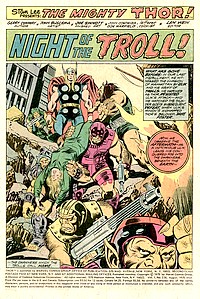 |
|
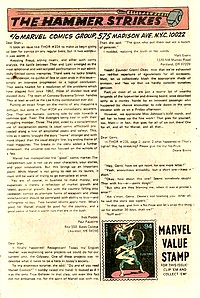 |
|
| |
| One attempt to counter this was
to have artists such as John Buscema only do layouts and
breakdowns, leaving the artwork to be finished by whoever
was inking - as is the case for Thor #238.
Marvel was clearly down to the wire, with what seemed
like an endless list of projects and not really enough
creative talent to go around and make it happen. |
| |
 |
|
But at
least Thor #238 wasn't an issue
to suffer from this, as legendary inker (and
excellent penciller in his own right) Joe Sinnott
did a perfect job in bringing John Buscema's
not-quite-finished pencils to life, resulting in
the dynamic artwork that readers had come to
enjoy and expect from Thor in the
mid-1970s. Sinnott enjoyed
a long career at Marvel, where he started back in
1950 when it was still known as Atlas- Whilst
perhaps best known for his inking of Jack Kirby's
pencils on the Fantastic Four, more importantly
in this case is the fact that he also inked
Thor's induction into the fold of Marvel's
superheroes from Journey
Into Mystery #83 (August 1962). In other
words: Joe Sinnott knew his Thor.
|
|
| |
| Accordingly, he pumped the
dynamics of John Buscema's breakdowns and layout
pencilling to the max with his inking, and the result is
pure Thunder God action as he takes his trusted hammer
from one fight to the next. |
| |
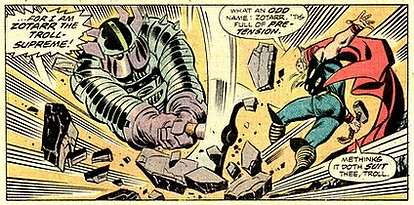 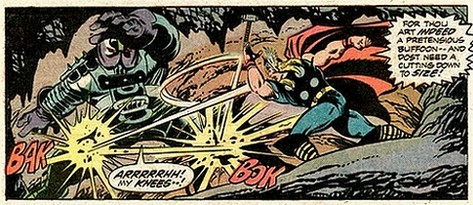 |
| |
| This mesh of a flowing story and a visual explosion
resulted in nothing less than a perfect example of how
1970s comic books could be a treasure trove of
entertainment - even if letterer John Costanza, a
seasoned professional of his trade, misspellt
"pretentious" and nobody else noticed before it
all went to the printers... Thor
was a title that featured regularly in Marvel's MULTI-MAGS,
and the issues provided great entertainment and high
quality creative work virtually all the time. So
thankfully readers would - with a bit of luck - be able
to pick up the conclusion to this story in a MULTI-MAGS the
following month. However, that yarn would not
be titled "Odinsong" at all... if you looked in
the right places, it was more than obvious that Marvel
was having the hardest of times trying to keep everything
together.
|
| |
 |
| |
|
| |
| FURTHER
READING ON THE THOUGHT
BALLOON |
| |
 |
|
The
Frankenstein Monster's own title
was cancelled after 18 issues the
same month that Marvel
Team-Up #37 hit the
newsagent stands; you can read
more about Marvel's Monster
of Frankenstein title here. |
|
|
|
| |
 |
|
Back in 2010
I took a comparative look at two
issues of Fantastic Four separated
by no less than 33 years of real
time: #186 and #580. While a lot
of change has since been wrought
on Marvel's first family
(including cancellation of the
title for a year in 2015), you
can see the differences between a
1977 and 2010 comic book here. |
|
|
|
| |
|
| |
| BIBLIOGRAPHY AMASH Jim (2010) Sal
Buscema - Comics' Fast & Furious Artist,
TwoMorrows Publishing
BRYANT JR. Robert
L. (2010) The Thin Black Line: Perspectives on Vince
Colletta, TwoMorrows Publishing
CONTINO Jennifer
M. (2005) "Englehart, Isabella, Wein & Luke
Cage: An Essential Interview", The Pulse, online at
comicon.com (5 July 2005) [retrieved from
web.archive.org]
COOKE Jon B.
(1998) "Stan the Man & Roy the Boy: A
Conversation Between Stan Lee and Roy Thomas", in Comic Book Artist #2,
Summer 1998
COOKE Jon
B. (2001) "Son of Stan: Roy's Years of
Horror", Comic
Book Artist # 13, Two Morrows Publishing
HOWE Sean (2012) Marvel
Comics: The Untold Story, Harper Collins
MILLER Jonathan
(2010) " Spider-Man and Company: The Wide World of Marvel
Team-Up", in Back Issue #44,
TwoMorrows
|
| |
|
| |

|
| |

(c) 2024
uploaded
to the web 25 October 2024
|
| |
|
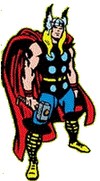
|
|































